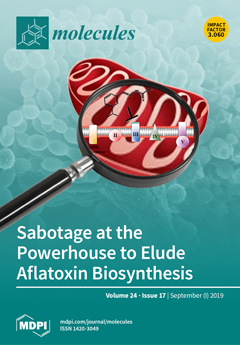Chemical investigation of
Cordia millenii, Baker resulted in the isolation of a new depsidone, cordidepsine (
1), along with twelve known compounds including cyclooctasulfur (
2), lup-20(29)-en-3-triacontanoate (
3), 1-(26-hydroxyhexacosanoyl)glycerol (
4), glyceryl-1-hexacosanoate (
5) betulinic acid (
[...] Read more.
Chemical investigation of
Cordia millenii, Baker resulted in the isolation of a new depsidone, cordidepsine (
1), along with twelve known compounds including cyclooctasulfur (
2), lup-20(29)-en-3-triacontanoate (
3), 1-(26-hydroxyhexacosanoyl)glycerol (
4), glyceryl-1-hexacosanoate (
5) betulinic acid (
6), lupenone (
7),
β-amyrone (
8), lupeol (
9),
β-amyrin (
10), allantoin (
11), 2′-(4-hydroxyphenyl)ethylpropanoate (
12) and stigmasterol glycoside (
13). Hemi-synthetic reactions were carried out on two isolated compounds (
5 and
6) to afford two new derivatives, that is, cordicerol A (
14) and cordicerol B (
15), respectively. The chemical structures of all the compounds were established based on analysis and interpretation of spectroscopic data such as electron ionization mass spectrometry (EI–MS), high resolution electrospray ionization mass spectrometry (HR-ESI–MS), fast atom bombardment mass spectrometry (FAB–MS), one dimension and two dimension nuclear magnetic resonance (1D and 2D-NMR) spectral data as well as X-ray crystallography (XRC). Lupeol ester derivatives [Lup-20(29)-en-3-triacontanoate (
3)], monoglycerol derivatives [1-(26-hydroxyhexacosanoyl)glycerol (
4) and glyceryl-1 hexacosanoate (
5)] were isolated for the first time from
Cordia genus while sulfur allotrope [cyclooctasulfur (
2)] was isolated for the first time from plant origin. Biological assays cordidepsine (
1) exhibited significant anti-HIV integrase activity with IC
50 = 4.65 μM; EtOAc extract of stem barks, EtOAc fraction of roots and leaves were not toxic against 3T3 cells.
Full article






